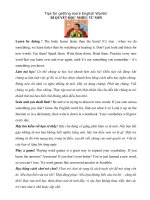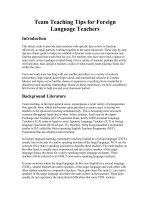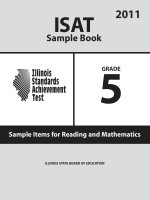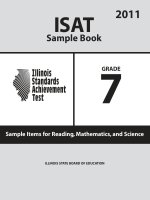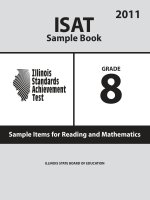Tips for reading
Bạn đang xem bản rút gọn của tài liệu. Xem và tải ngay bản đầy đủ của tài liệu tại đây (1.61 MB, 68 trang )
The Complete A to Z
Guide to IELTS
Reading
Introduction
How can this book help you with your reading?
Listening and reading are considered the ‘easy’ parts of the
IELTS test, but this does not mean that they do not require
preparation.
This book will take you step-by-step through the different
sub-skills that are required and the different strategies I
suggest for dealing with all of the different question types.
This book provides you with the means of preparing fully for
the reading test. It is designed as a complete A-to-Z guide and
should be read in its entirety.
The book will show you:
If you are reading this book, you already have the required
level of English to do well in both tests. What you are
probably lacking is a sound knowledge of the strategies
needed to get very high marks.
IELTS Writing Academy© 2016. All rights reserved.
•
•
•
•
•
•
The format of the test
General tips and common mistakes
Strategies for all question types
The reading sub-skills that are tested
How to improve your reading skills
How to improve your vocabulary
2
The Reading Test
Three reading
texts.
A total of between
2000-2700 words.
40 questions.
1 hour to answer
them.
The texts and
questions get more
difficult as the test
progresses.
Each reading text
will have 3-4
different types of
question.
You have no time
to transfer your
answers at the
end.
Academic
General Training
The texts are taken from journals, magazines, books, text books
and newspapers.
The texts are taken from general sources, such as adverts, notices,
government documents, manuals, leaflets, books and magazines.
The texts are of an academic nature, but you do not require a
specialist knowledge of the subjects to do well in the test.
The texts are intended to test a person’s ability to cope with
everyday life in an English speaking country.
IELTS Writing Academy© 2016. All rights reserved.
3
Reading Tips
How to use these…
Time is your enemy. Use it
wisely.
Read, read and then read
some more. Practice
makes perfect.
Be aware of what subskills they are testing in
each question.
Read the instructions VERY
carefully.
Each different question
type requires a different
strategy.
Improve your vocabulary
and you’ll improve your
reading score.
You don’t have to
understand every word.
Accept that you won’t
know everything.
Don’t waste too much
time on one question. If
you don’t know the
answer, move on.
These tips are simply to give you an
introduction to IELTS reading.
They are not intended to be the only
document you look at.
Many IELTS students think that ‘tips’ are
the only things they need to get a good
score. They are not.
Make sure you use these as an introduction
and use the rest of the document to really
progress.
IELTS Writing Academy© 2016. All rights reserved.
4
Question Type # 1
Short Answer Questions
Ability to skim the
passage quickly and
understand overall
meaning.
These questions are often called
‘comprehension’ questions and they are
very common in English classrooms all
over the world.
Ability to scan for
specific information.
Most students have answered these kinds
of questions before and, for this reason,
most students tend to do quite well with
them.
Understanding the
question being asked.
Here are the skills tested for these types
of question:
Thinking of possible
synonyms and
paraphrases of
keywords.
IELTS Writing Academy© 2016. All rights reserved.
5
1
Common problems:
Lack of awareness of synonyms and
paraphrasing.
Going over the word limit.
Reading every single word instead
of skimming and scanning.
Panicking when you see a word or
phrase you don’t understand.
IELTS Writing Academy© 2016. All rights reserved.
6
Tips for short
answer questions
The answers appear in the same
order as the text.
Look at and understand the
questions first, before you start
reading the text. What is the
question actually asking?
You will probably be given a word
limit, for example ‘NO MORE THAN
THREE WORDS AND/OR A NUMBER.’
Make sure you don’t go over this
limit.
IELTS Writing Academy© 2016. All rights reserved.
The answers do not need to be
grammatically correct, just short
answers.
Don’t give your opinion, just give the
answer that is in the text.
Keywords in the question will
normally be nouns or noun phrases.
When you find your keywords,
always think about synonyms and
paraphrases.
7
Strategy for Short Answer Questions
1. Read the instructions carefully and note the word limit.
2. Read and understand the questions. Think about the information
you will need to find.
3. Underline any keywords in the questions.
4. Think about synonyms or paraphrases for these keywords.
5. Find the part of the text the question relates to.
6. Read the question again.
7. Read the section containing the answer carefully and identify the
answer.
8. Continue with the next question and repeat until finished.
IELTS Writing Academy© 2016. All rights reserved.
8
Question Type # 2
Multiple Choice Questions
On both the academic and general IELTS
reading papers you are likely to be asked
multiple choice questions (MCQs).
You job is to simply choose the correct
answer from a list of possible choices.
Here are the skills tested for these types
of question:
Understanding the
main ideas contained
in a text.
Ability to scan for
specific information.
Reading in detail for
understanding.
Differentiating between
two or more possible
answers.
IELTS Writing Academy© 2016. All rights reserved.
9
1
Common problems:
Reading the text before looking at
the questions.
Not answering the questions at all.
Being tricked by ‘distractors’, such
as qualifying words.
Not reading the questions or text
carefully.
IELTS Writing Academy© 2016. All rights reserved.
10
Tips for multiple
choice questions
Read the questions before you read
the text.
Always write an answer. It is better to
guess than not answer at all.
Try to narrow the choices down to 2
or 3 out of the 4 possible answers.
This will increase your odds of getting
the question correct.
If you are unsure of the meaning, try
rephrasing the answers in your own
words.
IELTS Writing Academy© 2016. All rights reserved.
Be aware of ‘distractors’.
Don’t panic if you don’t know
anything about the topic.
Try to predict the correct answer
before you read the text.
Carefully read all of the options
before making your final decision.
The answers will be in the same
order as the text.
11
Strategy for Multiple Choice Questions
1. Read the questions carefully.
2. Skim the text to get the general meaning.
3. Underline any keywords in the question, and think about any synonyms that
might appear in the text.
4. Read the choices and underline any keywords. Think about the differences in
meaning between the different choices.
5. Predict the correct answer.
6. Read the text and, using keywords and synonyms, locate the part containing the
answers.
7. Read that part of the text very carefully, thinking about the difference in
meanings.
8. Don’t only think about which options are correct, but think about how the other
options are wrong.
9. Go back and read the question again, then mark your final choice.
IELTS Writing Academy© 2016. All rights reserved.
12
Question Type # 3
Summary Completion
You will be given a summary of
information from the text and there will
be some gaps in that summary.
You will either be given a list of words to
fill the gaps with, or asked to find the
answers in the reading text.
Your job is to insert some of the words
from the list into the gaps, or, if asked, to
fill the gaps with words from the text.
There will be more words in the list than
required to fill the gaps.
IELTS Writing Academy© 2016. All rights reserved.
Skills tested:
Scanning for the
correct information in
the text.
Being able to identify
synonyms and
paraphrases.
Understanding the
general meaning of the
summary.
13
1
Common problems:
Trying to fully understand every
part of the text.
Not being aware of synonyms and
paraphrasing.
Ignoring correct use of grammar.
Copying words from the text
instead of using synonyms or
paraphrase.
IELTS Writing Academy© 2016. All rights reserved.
14
Tips for summary
completion
Try to predict the answers before you
look at the options or the text. This
will help you spot the correct answer.
Should the gap be filled with a verb, a
noun, an adjective or an adverb? If
your answer makes the sentence
grammatically wrong, then you have
the wrong answer.
Look for synonyms and paraphrases
in the text rather than words that
match directly.
IELTS Writing Academy© 2016. All rights reserved.
Don’t spend too much time looking
for the answer to one question. If
you can’t find it, mark what you think
it might be and move on. Focusing on
the easier answers is a better use of
your time.
If you get a list of words, think about
the ones that can’t be the correct
answer because of meaning or
grammar. You can then eliminate
these words.
15
Strategy for Summary Completion
1. Read the question carefully. Note how many words you can write (normally one,
two or three), and if you should get the words from the reading text or a list.
2. Skim the summary and try to understand the overall meaning.
3. Try to predict the answers before you look at the reading text. Also, think about
the word type (noun, verb, adjective) that should be included.
4. If you have a list of words, try to guess which 2 or 3 the answer might be. Pay
attention to words that collocate well with the words in the sentence.
5. Identify which part of the reading text the summary relates to. Scanning for
synonyms from the summary will help you do this.
6. Look at that part of the section more carefully and choose the correct answer.
Remember to be careful with synonyms.
7. Check to see if your word makes the sentence grammatically correct.
IELTS Writing Academy© 2016. All rights reserved.
16
Question Type # 4
Matching Sentences
Skills tested:
You will be given a list of incomplete
sentences with no endings and another
list with possible endings.
Prediction.
Your job is to match the incomplete
sentences with the correct ending based
on the reading text.
Being able to identify
synonyms and
paraphrases.
This is not one of the more common
questions, but should be studied all the
same.
Understanding how the
ideas in the sentences
are connected to the
main ideas in the
reading text.
IELTS Writing Academy© 2016. All rights reserved.
17
1
Common problems:
Not reading or fully understanding
the correct parts of the reading text.
Not being aware of synonyms and
paraphrasing.
Looking for the exact words in the
reading text, rather than synonyms.
Trying to complete the sentences
using logic or grammar, rather than
using the reading text.
IELTS Writing Academy© 2016. All rights reserved.
18
Tips for matching
sentences
The answers are in the same order in
the text as they are in the questions.
Locate question one first, and then
you know where to begin.
Try to predict how each sentence will
end before you look at the endings.
Start with the incomplete sentences
first before you look at the endings or
the text. There are more endings
than required, so looking at all of
these in detail is a waste of time.
Spend more time on the first
question because this will be the
most difficult.
IELTS Writing Academy© 2016. All rights reserved.
Think of synonyms and paraphrases
that the examiners could be using
instead of the exact same words.
All of the sentence endings appear in
the text, but you don’t need to read
all of them, just the ones that you
decide to match with the incomplete
sentences.
When highlighting keywords, it is
often a good idea to highlight any
names, including place names, or
dates. These are often easy to find in
the reading text.
Don’t just match words. Make sure
the meaning in the reading text
matches.
19
Strategy for Matching Sentences
1. Read the question carefully.
2. Read the incomplete sentences first, and don’t look at the endings yet. Try to understand
what they mean and highlight any keywords especially names, places or dates.
3. Predict what the endings might be before looking at them. Think about what word type
(verbs, nouns, adjectives, adverbs) makes the sentence grammatically correct.
4. Look at the endings but not in too much detail. Try to see if there are any obvious
answers.
5. Eliminate endings that definitely cannot match. Think about grammar, collocations and
meaning.
6. Match the endings you think might be correct. Write two or three options if necessary.
7. Find the correct part of the reading text for each incomplete sentence. Be careful with
synonyms and paraphrases.
8. Understand the meaning of that part of the text and choose the correct answer.
IELTS Writing Academy© 2016. All rights reserved.
20
Question Type # 5
Sentence Completion
Skills tested:
You will be given a number of sentences
with gaps in them, and asked to complete
the sentences with words from the
reading text.
Understanding what
synonyms and
paraphrasing are.
These questions are as much vocabulary
tests as they are reading tests. They
require you to be aware of paraphrasing
(using different words to repeat a
sentence so that it has the same meaning)
and synonyms (words with the same or
very similar meanings).
Being able to identify
synonyms and
paraphrases
IELTS Writing Academy© 2016. All rights reserved.
Scanning for the
correct answer.
21
1
Common problems:
Trying to match words in the
question with the exact same words
in the reading text.
Not being aware of synonyms and
paraphrasing.
Not reading the instructions
properly.
Reading the text before the
question.
IELTS Writing Academy© 2016. All rights reserved.
22
Tips for sentence
completion
Check how many words it asks you to
write. If it says ‘no more than two’,
you can write one or two words. If it
says ‘no more than three’, you can
write one, two or three words.
Sometimes the question will state
‘using words from the text’ or ‘from
the text’. In this case you should only
use words from the text and not
change them or use different forms
of the words. If it does not say this,
then you are allowed to change the
words as long as the meaning is the
same.
Remember that your answer should
be grammatically correct.
When scanning for your answer,
make sure you are thinking about
paraphrasing and synonyms.
Find where the answer is located in
the text before you try to answer the
question. Remember, where before
what.
Read the questions before reading
the text.
The answers appear in the same
order as the questions.
IELTS Writing Academy© 2016. All rights reserved.
23
Strategy for Sentence Completion
1. Read the instructions carefully, noting how many words you can
write, and if they want you to include the exact words from the
question or not.
2. Read the incomplete sentences first. Think about what word form can
be used, and try to predict the answer. Also think about keywords
and how they could be represented by synonyms or paraphrasing.
3. Locate where the information is located by scanning quickly. If you
can’t locate the answer quickly, move on.
4. Read the incomplete sentence again.
5. Study the reading text more carefully to establish the answer.
6. Check your spelling.
7. Repeat with the other sentences.
IELTS Writing Academy© 2016. All rights reserved.
24
Question Type # 6
True/False/Not Given
‘True, False, Not Given’ questions require
you to identify if information in a text is
true, not true or not given.
You will be given a number of factual
statements and you have to check in the
text if it they are true or not.
This is probably the most difficult
question type on the reading paper.
IELTS Writing Academy© 2016. All rights reserved.
What do they mean?
If the text agrees with
or confirms the
information in the
statement, the answer
is TRUE.
If the text contradicts or
is the opposite to the
information in the
statement, the answer
is FALSE.
If there is no
information or it is
impossible to know, the
answer is NOT GIVEN.
25
